Tramel's ScissorTales: Has transfer portal helped OU & OSU basketball in the Big 12?
- Oops!Something went wrong.Please try again later.
ESPN’s Joe Lunardi came out with his NCAA Tournament bracketology this week. That’s right. A June projection of March Madness.
Sports’ answer to soap operas. Escapism at its finest.
But heck, we all need a little escape. And Saint Joseph’s Joe did me a solid with his way-way-way-way-way-way-way-way too early bracket. He made me a little more optimistic about Cowboy and Sooner hopes for next season.
Lunardi has OSU in the field of 68, with a No. 9 seed, and OU in the field, with a No. 11 seed.
Hey, I’m feeling better about the college basketball season. At this point, I had the Cowboys as a bubble team — maybe make the tournament, maybe not — and I had the Sooners as a lost cause, with the unexpected transfer portal defections.
But maybe a summer solstice reassessment is in order. The transfer portal has changed college hoops in a profound way. One player can make a huge difference. Two players can move mountains. And some schools are bringing in more than two players via the transfer portal.
Texas Tech and Iowa State, in particular, used the portal to great bounty last season; Tech to keep its footing in the wake of losing coach Chris Beard, Iowa State to reverse two seasons of despair. Both made the Sweet 16, and Tech, frankly, was as good as any team in America.
So I went to the portal this week. More than 1,450 major-college players signed up to transfer this off-season — 1,450! That’s more than four per team. Most have found a spot, though not necessarily the promised land of which they dreamed.
I can’t wrap my head around every team, not even every Power 5 team, much less every player. So I focused on the Big 12. How did Big 12 teams fare in the portal?
I see some portal rankings of teams, but they’re based on who’s coming in. I like to see who’s going out, too.
Here’s how I rank the Big 12 portal happenings. This is not a preseason prediction. This is not an overall recruiting assessment. This is strictly based on the additions and subtractions of the portal.
More: OU & Oklahoma State men's basketball opponents set for 2023 SEC/Big 12 Challenge

1. Texas Tech
Additions: Fardaws Aimaq, C, Utah Valley; De’vion Harmon, SG, Oregon; Malik Ondigo, PF, Rice; Jaylon Tyson, SF, Texas; Kerwin Walton, SF, North Carolina; D’maurian Williams, SG, Gardner-Webb; Mylik Wilson, PG, Houston.
Subtractions: Chibuzo Agbo, SG, Boise State; Sardaar Calhoun, SG, Drake; Kevin McCullar Jr., SF, Kansas; Terrence Shannon Jr., SG, Illinois.
The Red Raiders lost two veteran contributors in McCullar and Shannon, but coach Mark Adams returned to the mid-major well that served Tech so well last season.
A year ago, Adams added Bryson Williams from Texas-El Paso, Kevin Obanor from Oral Roberts, Davion Warren from Hampton and Adonis Arms from Winthrop. All were huge for the Red Raiders.
This year, the difference-makers look to be Aimaq, a 6-foot-11 center who averaged 18.9 points and 13.6 rebounds in the Western Athletic Conference; Williams, who averaged 14.5 points and shot 39.3% in the Big South; and Harmon, who played at Oregon last season much the same way he did at OU for two seasons. Solid player. Plus Tyson was ballyhooed recruit for Texas.
More: OU & Oklahoma State men's basketball opponents set for 2023 SEC/Big 12 Challenge
2. Kansas
Addition: Kevin McCullar Jr., SF, Texas Tech.
That’s right. KU lost no one to the portal and brought in just one player. What is this? 1969?
The addition was huge. McCullar is a jack of all army knives. A double digit scorer for Tech each of the last two seasons and a defender able to guard most anyone on the court.
3. Iowa State
Additions: Jaren Holmes, SG, St. Bonaventure; Tre King, PF, Georgetown; Osun Osunniyi, C, St. Bonaventure; Hason Ward, PF, Virginia Commonwealth; Jeremiah Williams, SG, Temple.
Subtractions: Tyrese Hunter, PG, Texas; Tristan Enaruna, SF, Cleveland State; Xavier Foster, C, Southern Methodist; Blake Hinson, SF, Pittsburgh; Tre Jackson, PG, Western Carolina; Javan Johnson, SF, DePaul; Jaden Walker, SG, East Carolina.
I might have the Cyclones too low. But the loss of Hunter was a huge blow. He appeared to be a star-in-the-making, and if anything Hunter appeared to be NBA Draft material. Instead, he went to Texas.
ISU coach T.J. Otzelberger rallied with four prime transfers, including St. Bonaventure teammates Holmes and Osunniyi. Holmes averaged 13.5 points a game, while Osunniyi averaged 11.3 points and 7.5 rebounds. Plus, Williams averaged 9.5 points at Temple and Ward averaged 6.5 points and 4.8 rebounds at VCU.
Looks like another successful makeover for Otzelberger.
'God just made me OU': How Antonio Record became the Marlins Man of Sooner athletics
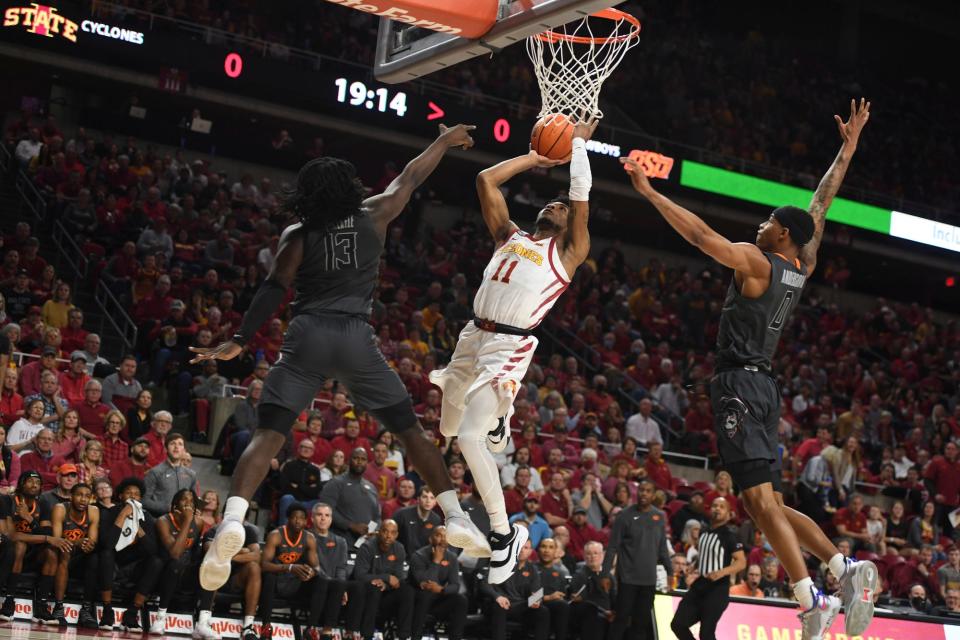
4. Texas
Additions: Tyrese Hunter, PG, Iowa State; Sir’Jabari Rice, SG, New Mexico State.
Subtractions: Devin Askew, PG, California; Tre Mitchell, PF, West Virginia; Courtney Ramey, PG, Arizona; Jaylon Tyson, SF, Texas Tech.
Beard ran roughshod over the portal a year ago. This year, the ‘Horns were more quality over quantity. Hunter is an absolute prize, and Rice averaged 11.9 points a game for NCAA Tournament team New Mexico State.
But UT’s portal defections were significant. Ramey was a four-year veteran who has produced in a bunch of big games. Askew and Mitchell were solid players.
5. West Virginia
Additions: Emmitt Matthews Jr., SF, Washington; Tre Mitchell, PF, Texas; Erik Stevenson, SG, South Carolina; Joe Toussaint, PG, Iowa.
Subtractions: Jalen Bridges, SF, Baylor; Isaiah Cottrell, PF, Nevada-Las Vegas; Sean McNeil, SG, Ohio State; Seny Ndiaye, PF, South Carolina-Upstate; Taj Thweatt, SF, Coastal Carolina.
The Mountaineers lost not only Bridges, but long-time and long-range shooter McNeil, plus Cottrell, who at least seemed to have a chance to become one of those Bob Huggins big men who wreak havoc.
But Matthews has returned; he averaged 11.7 points a game at Washington after spending three years with WVU. Mitchell averaged 8.7 points a game at Texas, Stevenson averaged 11.6 points at South Carolina and Toussiant started 41 games at Iowa over the past three years. That’s an interesting haul.
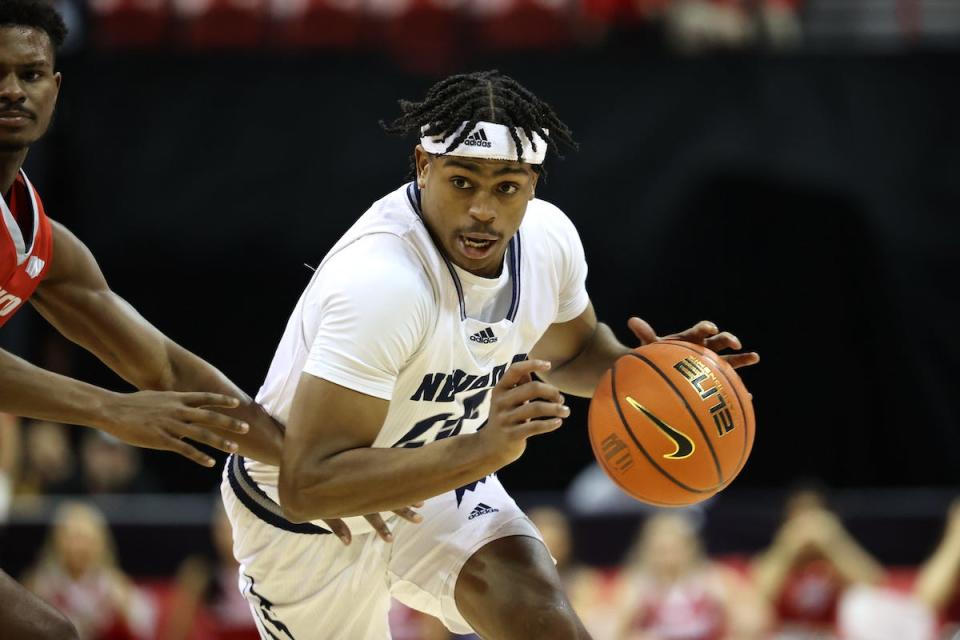
6. Oklahoma
Additions: Grant Sherfield, PG, Nevada; Joe Bamisile, SF, George Washington; Sam Godwin, PF, Wofford; Yaya Keita, PF, Missouri.
Subtractions: Elijah Harkless, SG, Nevada-Las Vegas; Umoja Gibson, SG, DePaul; Rick Issanza, C, Loyola Marymount; Alton Mason, SG, Missouri State; Akol Mawein, C, Sacramento State.
Harkless was OU’s best player last season and Gibson was a sharpshooter of considerable note.
Porter Moser rebounded by getting Bamisile, who averaged 16.3 points last season, and Sherfield, who averaged 19.1, both in high mid-major leagues.
7. Baylor
Additions: Jalen Bridges, SF, West Virginia; Caleb Lohner, SF, Brigham Young.
Subtractions: Dain Dainja, PF, Illinois; Matthew Mayer, SF, Illinois.
Mayer has been a Baylor stalwart, and while Dainja played just three games as a freshman, he was considered an elite prospect.
But Bridges has been a good player at West Virginia, and Lohner averaged 7.0 points and 6.4 rebounds at BYU.
8. Oklahoma State
Additions: John-Michael Wright, PG, High Point; Caleb Asberry, SG, Texas State; Russell Harrison, SF, Louisiana-Monroe.
Subtractions: Isaac Likekele, G, Ohio State; Rondel Walker, SG, TCU; Matthew-Alexander Moncrieffe, PF, Georgia; Keylon Boone, SF, Pacific; Donovan Williams, SG, Pacific.
Wright and Asberry appear to be quality additions. Wright averaged 17.4 points a game over three Big South seasons, and Asberry has been a quality shooter (36.1 percent) from 3-point range in the Sun Belt.
But OSU’s losses were significant — Likekele and Walker were key players, and Moncrieffe and Boone helped on occasion.
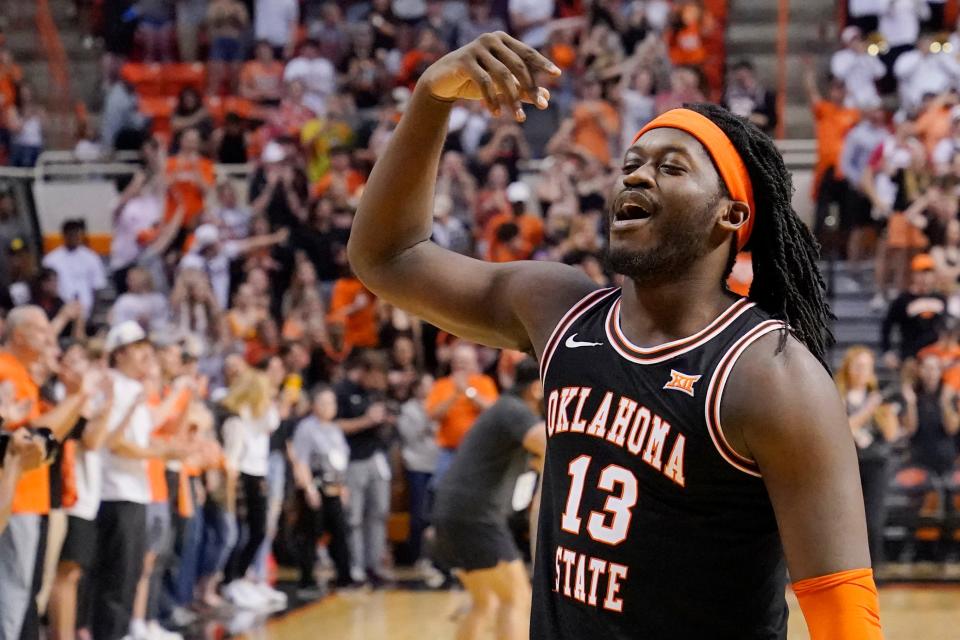
9. Texas Christian
Additions: Rondel Walker, SG, OSU; Tyler Lundblade, SG, Southern Methodist.
Subtractions: Francisco Farabello, PG, Creighton; Cashius McNeilly, PG, Northern Oklahoma Junior College.
The portal was rather slow for TCU. Walker’s a nice addition, but Farabello’s shooting will be missed.
10. Kansas State
Additions: Camryn Carter, PG, Mississippi State; Jerrell Colbert, C, Louisiana State; David N’Guessan, SF, Virginia Tech; Desi Sills, SG, Arkansas State.
Subtractions: Nigel Pack, PG, Miami; Davion Bradford, C, Wake Forest; Maximus Edwards, SG, George Washington; Kaosi Ezeagu, C, Sam Houston State; Drew Honas, PG, undecided; Luke Kasubke, SG, Illinois State; Logan Landers, PF, Grand Canyon; Seryee Lewis, PF, Rice; Carlton Linguard, C, Texas-San Antonio; Selton Miguel, SG, South Florida; Montavious Murphy, SF, undecided.
With the firing of coach Bruce Weber, the K-State turnover was great, and Pack’s transfer to Miami was one of the stories of the college basketball off-season. Miguel was a quality player, too, and Bradford and Ezeagu were big men who played.
New coach Jerome Tang brought in Sills, a 12.6 points a game scorer from Arkansas State, but that’s not likely to be enough.
She Said, He Said: Who the Thunder will draft No. 2 and who it should pick — is the answer the same?
Still no shortcuts for Thunder
The Thunder rebuild appears to still be taking the long road, just as Sam Presti said it would. No shortcuts.
The Thunder’s trade this week for JaMychal Green was a small clue — Green’s $8.2 million salary cut into OKC’s cap space, largely squashing those who dreamed of the Thunder pulling off a trade for the likes of Tobias Harris or someone making oodles of cash.
That never was in Presti’s plans, and now the math doesn’t even work.
But another NBA trade — this one not involving the Thunder — offered more clues about OKC.
The Rockets are trading power forward Christian Wood to the Mavericks for the No. 26 pick in the 2022 draft and inconsequential players Boban Marjanovic, Marquese Chriss, Trey Burke and Sterling Brown.
It’s a good trade for both teams. Dallas gets an offensive dynamo; Wood, 26, is 6-foot-9, can score (19.1 points per game in two Houston seasons) and rebound (9.9), and shoot (38.4% from 3-point range the last two seasons).
More: Thunder acquires JaMychal Green, consolidates NBA Draft capital in trade with Nuggets
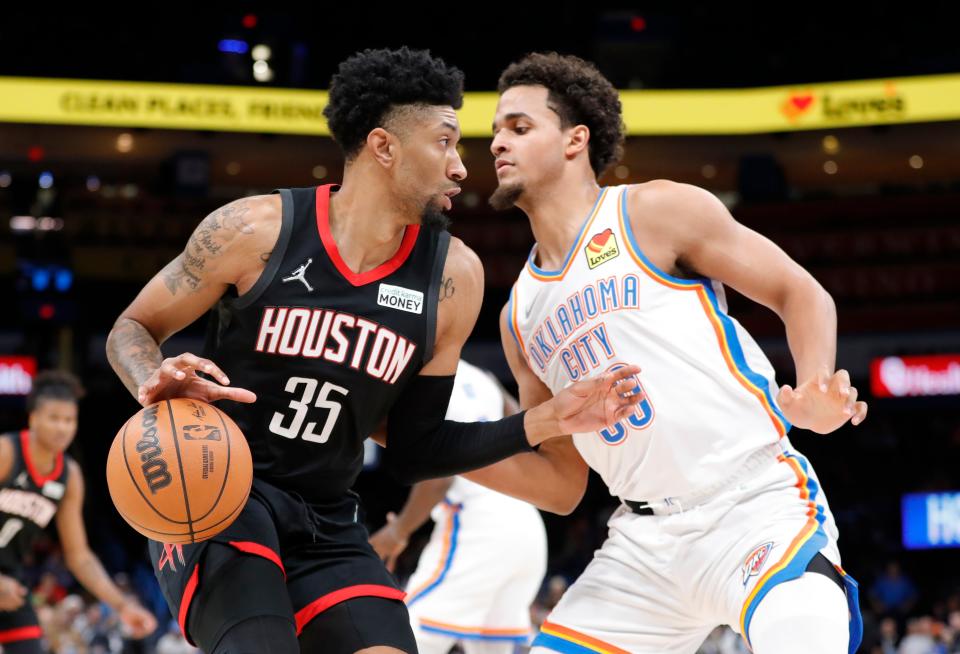
Wood has not shown much defensively, but he’s been playing in Detroit and Houston, which have been not interested in winning. Maybe Dallas’ defensive culture can ignite Wood.
Houston clears playing time for center Alperen Sengun, drafted a year ago, and whoever the Rockets draft third overall next week, probably Duke’s Paolo Banchero. It’s a clear rebuilding move for Houston.
That’s the mode the Thunder remains in, too.
Think about it. Wood would be a wonderful fit for OKC. A sharpshooting big man? Wood is Mike Muscala, only younger and with more offensive talent. And Muscala was excellent working with Shai Gilgeous-Alexander last season.
If the Thunder wanted Wood, it seems likely it could have gone swung that deal. Dallas gave up the No. 26 pick and four irrelevant players whose prime involvement was making the salaries match.
OKC could have trumped that deal. Could have offered the No. 30 pick, players to make the salaries match (Derrick Favors and Isaiah Roby would have done it), and perhaps a future pick just to seal the deal. Or maybe not on the latter; the Rockets have to get rid of some players, since it took on so many from Dallas. OKC could have saved them the trouble.
But adding a player like Wood would have accelerated the Thunder rebuild, perhaps to its detriment.
Is Wood a building block on an elite team? Maybe. No way of knowing. That’s a Dallas experiment now.
But Wood is a free agent next summer. If he plays well and it works out with the Mavs, he’ll command a high price for his next contract. If it doesn’t work out in Dallas, the Mavs keep looking for the right fits around Luka Doncic.
A huge contract in summer 2023 is not in the Thunder’s plan. OKC already has committed big money to SGA. Luguentz Dort’s next contract is up next summer; the Thunder must make a decision on how much Dort is worth (in my mind, a bunch).
Josh Giddey showed signs of becoming an elite player as a rookie. If that happens, he’ll eventually require a big salary. Then of course, either Jabari Smith or Chet Holmgren is about to hit Loud City as the No. 2 pick in the draft. If things go as planned, four years from now, whichever is thriving for OKC will get paid, too.
The lottery luck gave Presti options to speed up the process. Trade for a Harris type or a Wood type. Quit worrying about the draft.
But the NBA is about to get a new collective bargaining agreement, which will include all kinds of details that are monotonous to us but huge to the Thunder brain trust. The details matter. The last CBA had details that helped the Warriors entice Kevin Durant.
Presti is making no major, unnecessary moves, until the CBA structure is known.
And that includes a trade for Wood, which cost the Mavericks very little and made them quite optimistic about the 2022-23 NBA season.
Tramel: Ten years ago, Thunder hosted the Finals; when will they return to OKC?
Tulsa getting new neighbors again
Mid-1990s conference realignment elevated the profile of University of Tulsa football.
But 2020s conference realignment might do the opposite for the Golden Hurricane.
American Conference commissioner Mike Aresco said Wednesday that his league’s new members will begin play in summer 2023, replacing the expatriates (Cincinnati, Houston and Central Florida) headed for the Big 12.
The American newcomers: Charlotte, Florida Atlantic, North Texas, Rice, Alabama-Birmingham and Texas-San Antonio. All are coming from Conference USA.
Tulsa has been in this script before. Almost a decade ago, TU was in a league that was joined by Florida Atlantic, North Texas, UTSA, and Charlotte (the latter for basketball), all coming to Conference USA.
What goes around comes around.
All of the C-USA members headed for the American bring something to the league, of which Tulsa has been a member since 2014. But none of the newcomers are anything approaching what the American is losing.
In the last 15 years, Cincinnati, Houston and UCF have combined for seven major bowl trips and 16 appearances in the final Associated Press poll. Over that time, the six American newcomers have zero major bowl trips and zero top-25 finishes. Only UTSA, in 2021, appeared in any AP poll at all.
Tulsa has not had the craziest journey through conference realignment, but it’s been quite a ride for the Golden Hurricane. That vote might go to TCU (Southwest Conference, Western Athletic Conference, Conference USA, Mountain West, Big East without ever competing, finally Big 12). All that’s left is the Justice League of America.
Anyway, when the Big Eight and four prominent SWC schools formed the Big 12 in 1996, the Golden Hurricane soon enough found itself in the WAC.
The WAC – the launching pad of Arizona State and Brigham Young into the national consciousness – was a big upgrade in branding for TU. The WAC had a reputation for good programs; Arizona State and Arizona were long gone to the Pac-10, but the likes of BYU, Utah, San Diego State, Air Force, Colorado State and Wyoming remained in the WAC.
So did Nevada-Las Vegas, which that decade had won an NCAA basketball championship and had a national identity.
Also joining the WAC were SWC refugees Southern Methodist, Rice and TCU. Those programs were struggling, but it still lifted Tulsa’s profile.
But half the WAC bolted and formed the Mountain West in 1999. Gone were BYU, Utah and most of the original WAC.
Nevada joined the WAC in 2000. Boise State and Louisiana Tech in 2001.
Tramel: How the late, great Oklahoma City Blazers helped OU reach the College World Series
That meant a total of 18 conference members for Tulsa in its six WAC seasons.
And by 2005, TU itself was on the move, jumping to Conference USA.
C-USA had formed in 1996, another realignment limb, amid great promise – its six members were Houston, Cincinnati, Louisville, Southern Mississippi, Tulane and Memphis. Its basketball members also included Marquette, DePaul, Saint Louis, South Florida, UAB and Charlotte.
Some of those were gone by Tulsa’s first year in C-USA, and TU won the football championship that first season, 2005, beating Central Florida 44-27 for the title. Also in the league that year were Memphis, Southern Miss, East Carolina, UAB, Marshall, Texas-El Paso, Houston, SMU, Tulane and Rice.
That version stayed together for eight years, remarkable consistency in these times.
But in 2013, UCF, Houston and Memphis left to join remnants of the Big East to form the American. Replacing them were Florida International, Middle Tennessee, Florida Atlantic, North Texas and UTSA, plus Old Dominion and Charlotte for basketball.
A year later, Tulsa got the invitation to join the 1-year-old American. The Hurricane was back with UCF, Houston, SMU, Memphis, Tulane and East Carolina. New blood, at least from Tulsa’s perspective, was Cincinnati, Temple, South Florida and Connecticut.
Navy came aboard for football in 2015. Wichita State did the same for all other sports in 2017.
Now the realignment of the ‘20s has struck again, and Tulsa is back on the treadmill. Everything that’s old is new again.
Come 2023, Tulsa over a 25-year period will have been in a league with 37 schools, 36 of which play football. That’s 27.5 percent of Division I-A.
I don’t know if that’s the most over the last quarter century, but it ought to be. Louisville has spent the last 25 years jumping from Conference USA to the Big East to the American to the Atlantic Coast, but the Cardinals have had only 29 conference mates, and even if you add basketball, it’s just 36, still less than Tulsa.
Counting the 1995 season, TCU also has had 37 fellow conference members, though that doesn’t count the Big East, since the Horned Frogs never actually made it to that league.
The new-look American will lower Tulsa’s profile but enhance TU’s competitive standing.
The Golden Hurricane had its moments in the American — TU played Cincinnati to the wire in the 2020 American championship game — but overall went 27-36 in conference play.
With the heavyweights gone, the American’s penthouse is for rent. Tulsa stands as good a chance as any to get the keys.
But the Golden Hurricane shouldn’t get too comfortable with its new neighbors. Someone’s always itching to move.
More: Tramel: OU baseball's stealth rise to College World Series gives hope for future in SEC
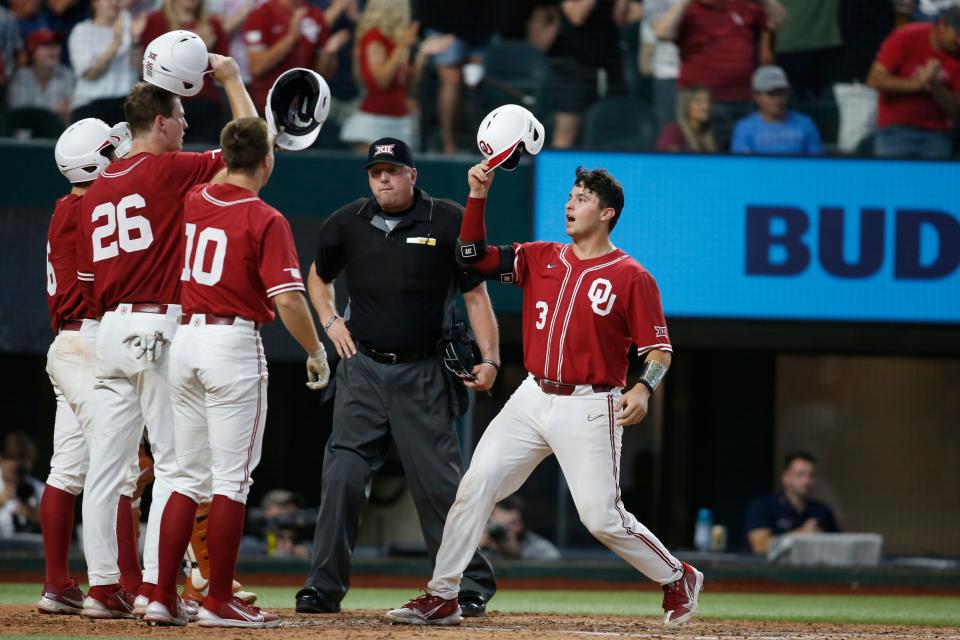
The List: CWS appearances
OU is in baseball’s College World Series, which starts at 1 p.m. Friday with the Sooners playing Texas A&M. This is OU’s 11th CWS appearance. Where does that rank the Sooners? Tied for 14th all-time. Here’s the top-10 list:
1. Texas 38: The Longhorns have won six NCAA baseball titles and have a record of 88-63 in Omaha.
2. Miami 25: The Hurricanes have won four NCAA baseball titles and are 48-42 in Omaha.
3. Florida State 23: The Seminoles have not won the NCAA baseball championship and are 30-46 in Omaha.
4. Arizona State 22: The Sun Devils have won five NCAA baseball titles and are 61-38 in Omaha but haven’t been since 2010.
5. Southern Cal 21: The Trojans have won 12 NCAA baseball titles and are 74-26 in Omaha but haven’t been since 2001.
6. Oklahoma State 20: The Cowboys have won one NCAA baseball title, in 1959, and are 40-38 in Omaha.
7. Arizona 18: The Wildcats have won four NCAA baseball titles and are 43-32 in Omaha.
7. Cal State-Fullerton 18: The Titans have won four NCAA baseball titles and are 34-31 in Omaha.
7. Louisiana State 18: The Tigers have won six NCAA baseball titles and are 40-27 in Omaha.
7. Stanford 18: The Cardinal has won two NCAA baseball titles and is 41-31 in Omaha.
Carlson: OU baseball heads to College World Series on backs — and arms — of Oklahoma-bred pitchers
Mailbag: OU softball greatest team ever?
My Tuesday ScissorTale about OU softball’s status as one of the greatest teams of all time drew considerable interest. I trotted out 1992 UCLA and 1994 Arizona as possible claimants for the crown.
Greg: “Enjoyed your article, but one thing I would mention is the girls of today are more explosive and athletic than any other era. Guess that’s hard to quantify but it’s true. Crazy how athletic OU girls are. Looking at a still photo of Jayda Coleman’s catch at the centerfield wall (against Texas) makes me think she might be able to dunk a basketball if she could grip the ball.”
Tramel: I agree. I remember Arizona circa '94 being bigger and stronger than most of their rivals. Does that put the Wildcats ahead or behind the modern Sooners? I don't know. UofA was scoring big in an era when no one else was scoring much at all. OU is scoring huge in an era when scoring has increased.
Berry Tramel: Berry can be reached at 405-760-8080 or at btramel@oklahoman.com. He can be heard Monday through Friday from 4:40-5:20 p.m. on The Sports Animal radio network, including FM-98.1. Support his work and that of other Oklahoman journalists by purchasing a digital subscription today.
This article originally appeared on Oklahoman: How college basketball transfer portal has affected OU & OSU in Big 12

